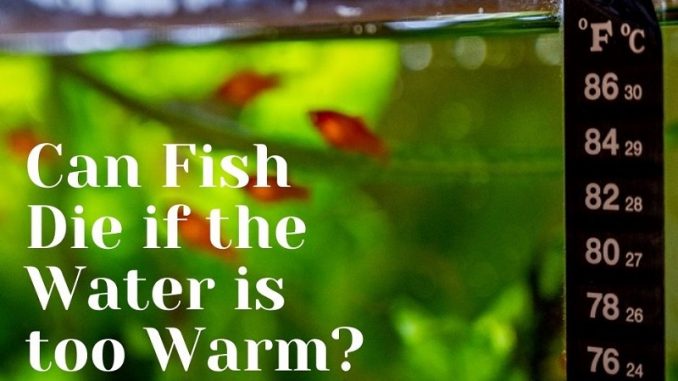
Different kinds of fish thrive in different water temperatures. In natural habitats, the water temperature affects the way fish grow, reproduce, and feed. Like birds, fish are cold-blooded creatures. That means their body temperature is directly affected by their environments – they have no internal mechanisms to help them warm-up or cool off as mammals do.
Wild fish often migrate in search of warmer or colder waters when the seasons change, but fish living in aquariums don’t have that option. Therefore, fish owners must learn what temperature water their pet fish need, and how to best maintain that temperature in the aquarium.
When you have a variety of fish in your tank, it will be impossible to maintain optimal water temperature for every type. But most fish will survive living in slightly warmer temperatures than they require.
On the other hand, it is not necessary to maintain a perfectly constant water temperature 24 hours a day. In nature, water is generally warmer during the day, and cooler at night. And most fish can tolerate slight changes in the temperature. Most fish also won’t suffer if the water gets too hot for a very short period of time. But if the temperature is too high for days on end, the risks to the fish increase.
Many factors affect the temperature in your aquarium water: the volume and depth of the tank, the water quality, the room temperature, and how much water circulation and surface agitation there is. Some fish owners create circulation and oxygen production artificially with a pump and filter. The sophistication of the equipment you purchase depends again on the size of the tank, and how many fish you want to keep.
Have you ever observed fish in a public pond or at the zoo? Unless people are throwing them crumbs, you usually won’t see many fish near the surface on very warm days. If you look carefully, you will see them congregating near the edges of the water, hiding among vegetation growing near the shore. That is how they cool themselves during the hottest times of the day. But in an aquarium, there is nowhere for the fish to go. There is no way for them to escape to a cooler location if they get too hot. Therefore, it is your responsibility as a fish owner to do everything you can to keep the water in your tank or aquarium at a comfortable temperature for your fish.
Fish and Oxygen
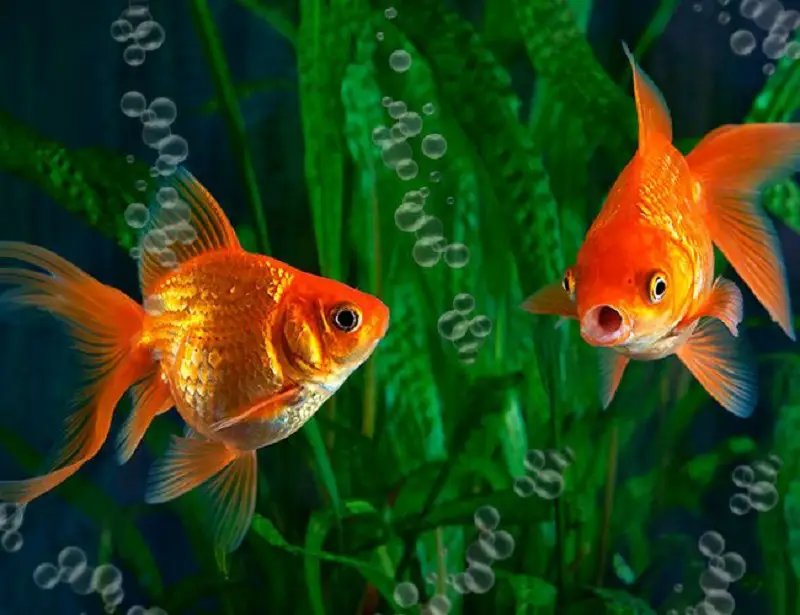
Fish breathe by drawing oxygen from the water they live in. The warmer the water gets, the more active fish become, and they then need increasing amounts of oxygen to survive. On the other hand, warm water has less oxygen in it than cool water. If the water temperature in your tank gets higher than 90°F(32°C), your fish may be in danger of dying. Their inability to get sufficient oxygen from the water they live in causes death by suffocation.
When the water in a fish tank is too cold, your fish will minimize their movement and may even appear catatonic. But when the water is warm, fish become extremely active. Their metabolism increases, causing an increased demand for food and oxygen. A fish that lives in water that is 75 degrees will eat up to five times the amount of food as the same fish living in 58-degree water. The increase in heat causes the digestive process to speed up, along with the fish’s efforts to absorb enough oxygen. Since there is less oxygen in warmer water, the fish has to pump much more water through its gills to get the oxygen it needs. That also contributes to an increase in appetite.
Fish and Bacteria
Along with water and fish, every tank or aquarium holds beneficial bacteria that break down accumulated ammonia. When there isn’t enough oxygen in the water, ammonia starts building up. The ammonia further displaces oxygen and starts to burn the fish gills.
Fish get physiologically stressed when the water in their habitat is too warm. The stress causes damage to their immune systems, which in turn makes them susceptible to illness and death caused by bacteria and parasites in the water.
Signs that the Water Temperature is Harming your Fish
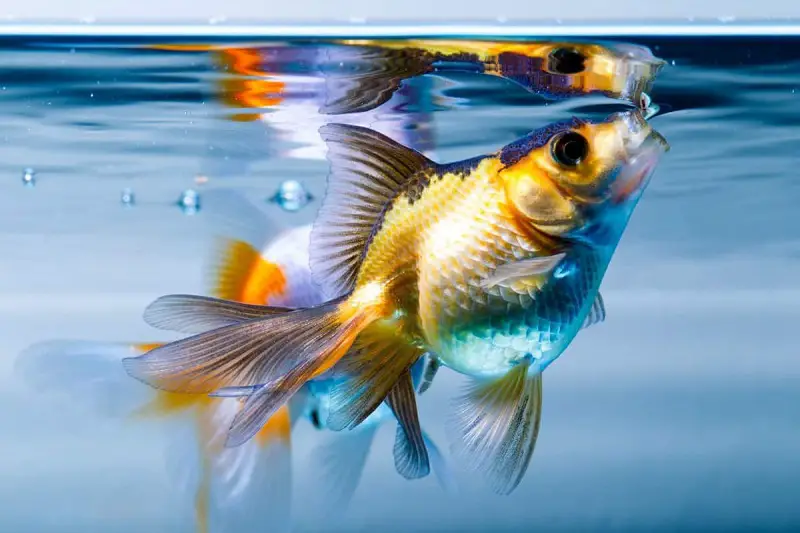
When fish get stressed due to heat, they will exhibit rapid gill movement or will rise to the water’s surface and appear to be gasping for air. Any anemones or corals you have in the tank will close, and their tentacles will retract. You will notice an increase in algae in the water, and the water may seem to get dirty or cloudy looking more frequently than usual. This is particularly dangerous because if the tank’s filtering system doesn’t function properly, toxic nitrate and ammonia build up in the water can kill your fish before the actual heat does.
Signs that your fish are in danger of death include: banging into the sides or bottom of the tank when swimming, bulging eyes, loss of appetite, rapid swimming, color changes, and hiding.
Cooling Tank Water without Killing your Fish
The best temperature for the common types of tropical fish that people keep as pets is 75°-78°F. Common goldfish, which are the most popular and least expensive pet fish, thrive at between 62° and 68°F. Fancier types of goldfish need to live in slightly warmer water, at 68°to 74°F. Tropical fish such as Rams, Discus, and Clown Loaches do best in water that is between 74° and 80° F.
This means that water that would be perfect for Ram fish would be far too hot for goldfish. When choosing fish for your aquarium, research what temperature each type does well in, and choose fish that need similar living conditions.
For example, many aquariums are equipped with heaters to keep the water sufficiently warm in the winter. These heaters have built-in thermostats, and automatically switch off when the water temperature starts getting too hot. But if you think the water in the tank has topped 30 degrees, and you manually turn off the heater, the water might get too cold at night and the extreme temperature fluctuations will harm your fish.
Some fish owners think that adding very cold water to a hot aquarium is a fast and simple way to bring the temperature back down to normal. But that is also dangerous because cooling that occurs too rapidly is stressful to fish.
So what can you do if you realize the water in your tank is too hot? The best solution in an emergency is to remove the lid of your tank and direct a fan towards the surface of the water. This will cause the water to cool with evaporation. But make sure the water level isn’t too high, or your fish might propel themselves right out.
WARNING: Never lower the water temperature more than two to four degrees Fahrenheit in a four-hour period. The best practice is to make sure it doesn’t get too hot in the first place!
How to Prevent Tank Water from Overheating
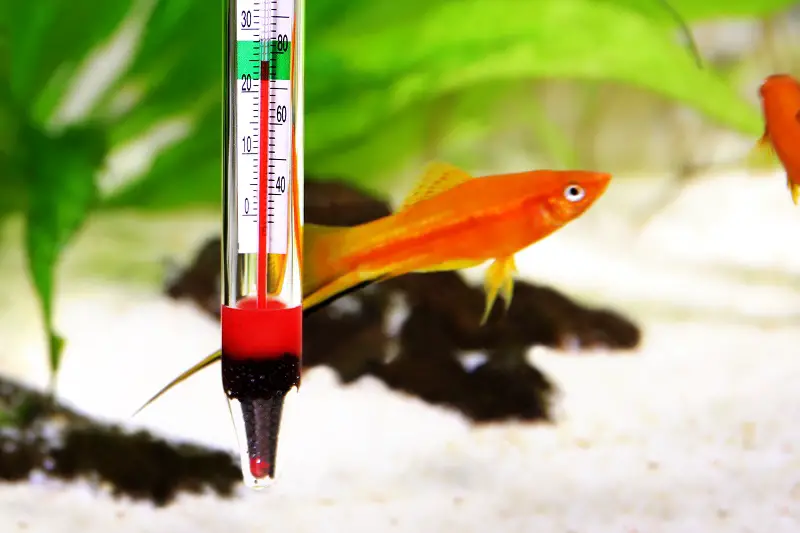
There are a number of different things you can do to protect your fish from death caused by tank water that gets too hot.
- When changing the aquarium water, do it slowly and gradually to maintain a stable temperature. But add slightly cooler water than what was already in the tank.
- Turn off the aquarium light for several hours a day, or all day long, to reduce heating. LED lights emit less heat than the older types of bulbs. Never leave the light on at night. Fish need dark, undisturbed sleep as much as we do!
- Place your aquarium in a sheltered area, away from fireplaces, heating vents, space heaters, direct sunlight, and doors leading directly outside.
- Don’t put the aquarium near an active air conditioner, as the cold air may cause the heater in the water to work harder, making the water warmer than it needs to be.
- Make sure that the heater in your aquarium is appropriate for the size of the tank. You don’t want a very powerful heater in a very small amount of water.
- Install a thermometer in the tank, so you can regularly check the water temperature. It’s a good practice to check the thermometer at the same time at least twice every day, when you feed the fish, or when you turn the light on or off in the morning and evening.
- Turn the heater down on hot days, but never turn it completely off. If you notice that the heater is making the water too hot, replace it before it literally cooks your fish!
In a real emergency, when you don’t have the time or ability to put any of the suggestions above into practice, you can float small, closed bags of ice in the tank. The slowly melting ice will gradually cool the water in the tank. However, never drop pieces of ice directly in the water, in the ice was made with de-chlorinated water.

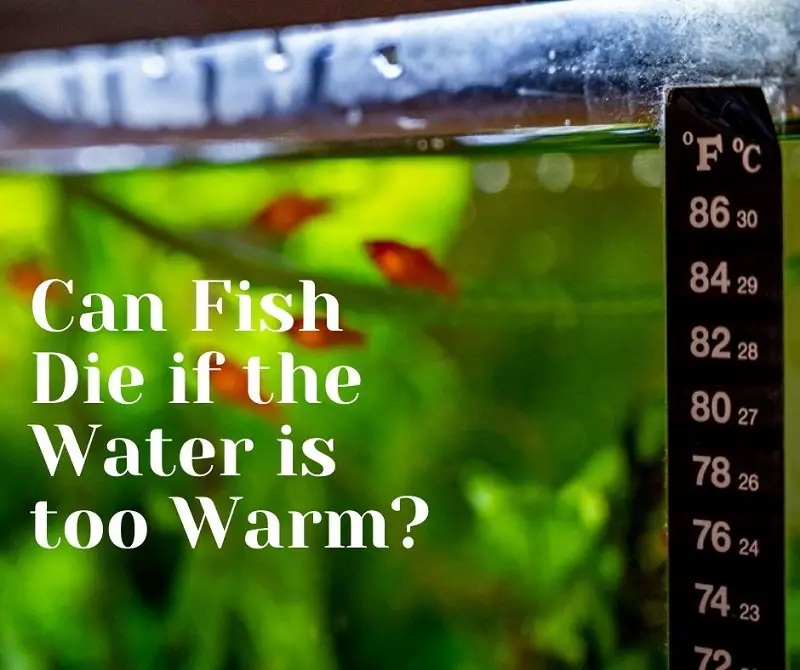
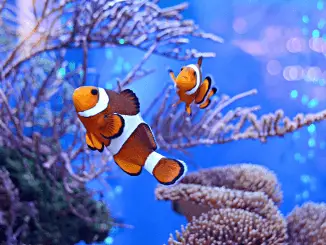


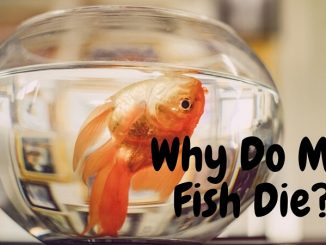

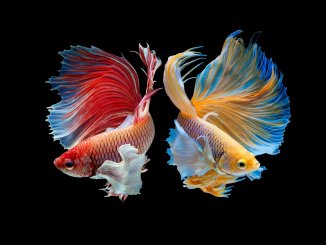
As an aside, birds are warm blooded which is why their eggs must stay warm to survive.
How about lizards, who are cold blooded but their eggs need to be kept warm to survive? The same goes for snakes, turtles, crocodiles, tortoises, etc. All of which are cold blooded.
Birds are warm blooded, but your explanation is incorrect.
Lizards are completely different than fish.
Hi,
We have goldfish in our pond and had a few really hot days in a row, they are suffering but surviving at over 36C (97F). I know that’s insanely hot, a moment ago I threw a bag of ice in there which cooled the local area down a couple of deg C. We had a little indoor air pump but it died (got water in it). We bought a new air pump 2100 Lt (555 Gallon) per hour.
I reckon that’s what is keeping them going.